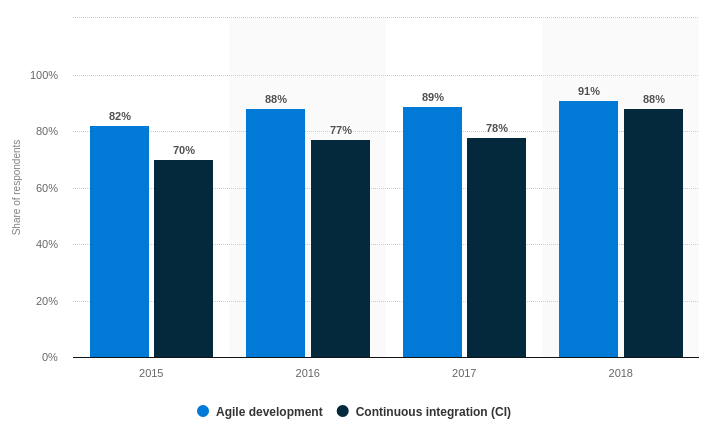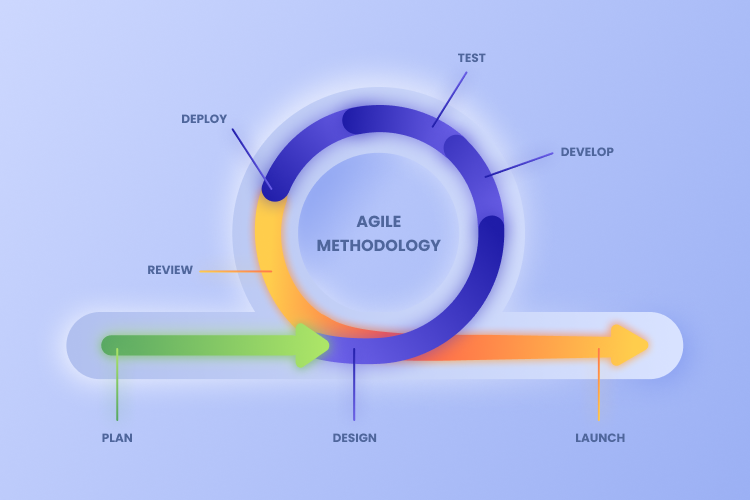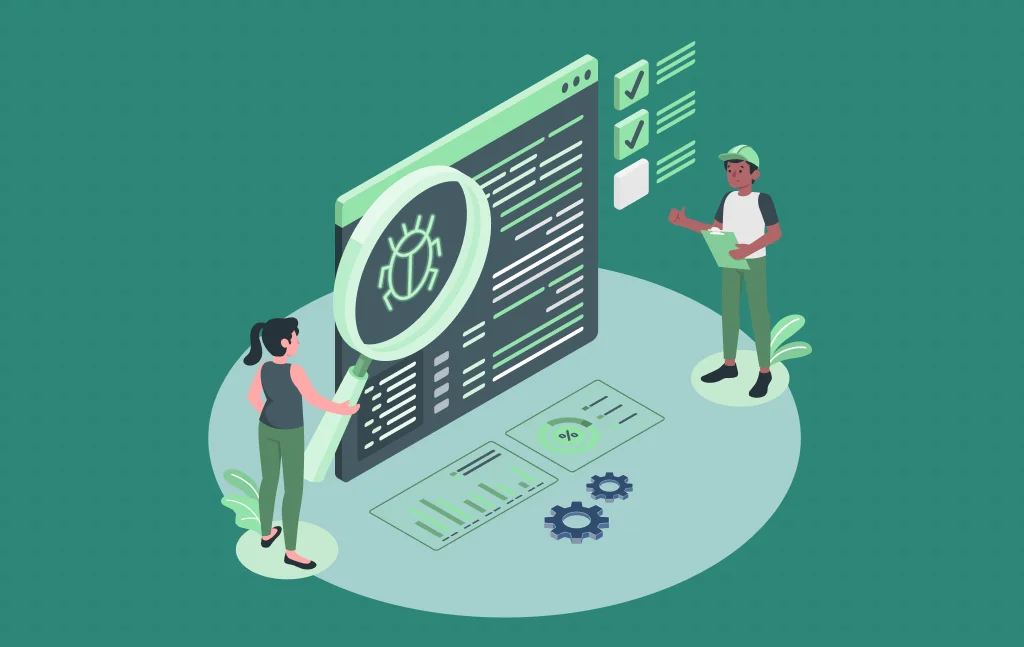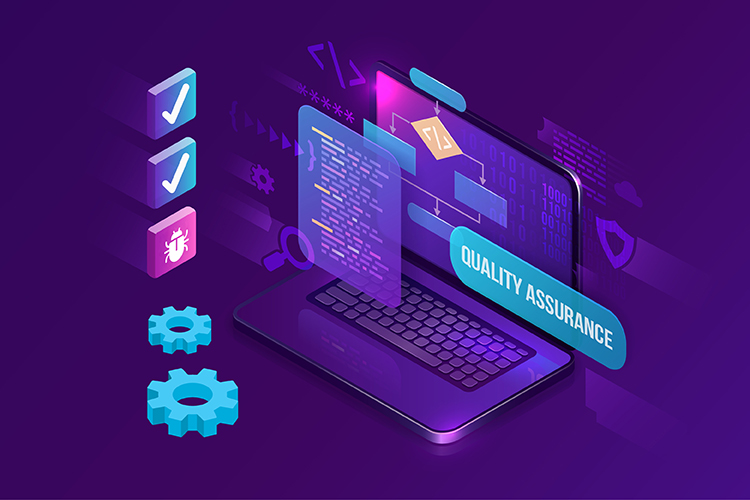Agile Testing Methodology – Life Cycle, Benefits, and Best Practices
- QA
- June 18, 2021
The era we live in is highly competitive. Organizations are in need of the tools and processes which can be used to meet the fast-paced delivery with minimum cost and excellence. The concerns raised by organizations are either on software stability, address issues before they bang the end-users and s/w release on time.
With a continuous shifting of digital exemplar, organizations that are able to keep pace with rapid advancements in technology and adopting new trends are witnessing positive changes in their business environment.
Software testing tends to operate in silos, challenging unification, which results in impoverished quality, speed, and cost. In such a scenario, what comes to the rescue is Agile Methodology.
It is necessary to adopt a new way of working to enjoy the perks of Agile methodology, MindInventory highly recommends Agile, which is being adopted globally.
The Statista report shows the portion of software developers worldwide that have embraced agile development approach and continuous integration (CI) rehearses around the world, from 2015 to 2018, based on a survey of development professionals.

As of early 2018, 91 percent of respondents showed their organization had received an agile development methodology, while 88% practiced continuous integration.
What is Agile Testing?
The traditional development process goes through a well-laid-out series of abstraction, designing, coding, testing, and deployment that may take months or even more than a year for a project to complete and make it available to the end-users.
But such an approach is thoroughly bungling to address the demands for apps. This is where the significance of agile development becomes protrustive.
“Agile testing is a ceaseless procedure which is dissected in multiple phases. Features and functionalities are added with every new delivery which results in managing the product seamlessly and gives higher customer satisfaction.”
Agile Testing Life Cycle
While traditional methodologies require the user to provide a detailed plan of the pre-decided requirements with respect to the intended software. Agile development gives flexibility due to its iterative technique.
Here given is the Life cycle of Agile Testing:
1. Planning Sprints
Sprints are the core of Agile methodologies, an approach that takes large, complex projects and fragments them into smaller manageable pieces. It is the pre-agreed time period in which the team has to work upon the set of requirements and conclude within the duration.
The Sprint kick-off meeting involves the product owner, developers, and testers who talk through goals that need to be attained in each of the sprints.
The daily scrum needs to be kept, where the team comes to talk about the assignments they are working on, what they have finished and any issues or obstacles that are blocking the work.
2. Designing Test Cases
It is important for the testing team to maintain a cadence with the development team. The testing team designs the test cases as per the requirements provided in the functional requirements document(FRS) and project design documents.
A test case design enlists how you will go about setting up the entire testing technique. These designs corroborate quality tests to stick to the enacted process. The documented test cases are then handed over to the QA manager and Developers for review which helps in Defect Prevention.
3. Quality Verification and Validation
This process is to check the quality of the developed software. As soon as the development gets completed and made available for QA, the testing process starts. The team works together to execute testing in an agile environment.
4. Review Product Stability
Usually, a customer wants to add or remove some of the features, change their product, or even change their complete idea. Agile is equated to iterative development, that is, New requirements can be accommodated at any stage of the development process without adding to the complexities.
Where it gives free hand to add or remove features during the development, it is also important to know and restrict the requirement flow and ensure product stability.
The testing team’s responsibility is to validate the requirement changes and sustain stability.
5. Regression and Deployment
To check the impact on the existing functionality, the manual and automated test cases are run after new user stories are added to the agile development process in order to deploy the quality product.
What Are Agile Best Practices?
Flexibility, Sustainability and Quality are pillars of Agile Software development. For better understanding of the Agile methods, here are some of the best practices for efficient and effective interaction on Agile teams.
1. Customer Satisfaction through Customer Collaboration
When we talk of Agile, the first and foremost priority is to give Customer Satisfaction. In a traditional development method, the customer is involved in the beginning when the requirements are discussed and at the end when the project is delivered which leads to customer disappointments.
Feedback is a necessity to build a great product and hence in the Agile approach, the customer is involved throughout the process, for communicating on options, clarifying expectations and collaborating on fixes. The continual communication between the team and the customer encourages inventiveness and better customer satisfaction.
2. Teamwork
In Agile, a group of individuals works together as a team leading to affluent projects.
For an agile team, it is significant to increase teamwork through coordination, effective communication, mutual support and contributive mindset. Together, agile teams can be entitled to take visionary moves that result in an advanced product.
3. Motivated Individuals
Motivation guides creativity. It is a key factor for any organization. Motivated individuals carry a goal in their day to day work and are individuals who are focused and love their job to do better. Motivated agile teams are boon to any organization and co relate fast-paced speed.
4. Team that organize their work
Agile software development is navigated through self-organizing teams who work in symmetry. Self-organizing teams are susceptible enough to decide how they will accomplish the work and who will do what. They split their tasks into small iterations and complete them within a sprint.
What Are The Benefits of Agile Testing Methodology?
The prominent factor that plays a key role in ensuring the success of Agile testing for a product, is to have a team with the essential characteristics of an Agile tester, who can build a culture of self-organization and independent thinking.
There are eight simple benefits to promote Agile testing, which are: Flexibility, Segregation, Reusability, Efficiency, Timely-releases, Acceptability, High-quality product delivery, and a Happier team.
- It is flexible enough to adapt changes in between sprints by incorporating changed requirements.
- As the tasks are segregated, it gives clarity which eliminates errors.
- It provides support for using reusable indexes and lets you focus on the latest customer’s needs and expectations rather than following documented broad requirements.
- This method is more efficient as the errors and defects are more closely figured out due to small fragments of code being tested.
- It helps to deliver quality software in a timely manner.
- To ensure the software is acceptable to stakeholders and end-users, feedback is appreciated to design software according to their point of view.
- Agile principles are reliant on simplicity to provide ease in the team processes like Scrum meetings and development practices.
- With the daily standups, Test reports can be discussed, and bugs can be addressed quickly.
Conclusion
Agile is considered as the ascendant framework and thus the environment will naturally stout resulting in a happier team delivering satisfaction and trust to the customer. This write-up strives to cover the entire process of Agile Testing and how it is beneficial to the final product.













